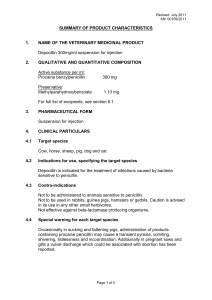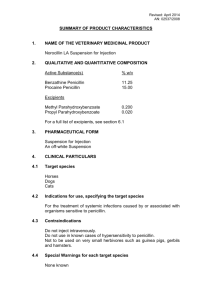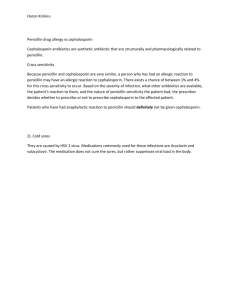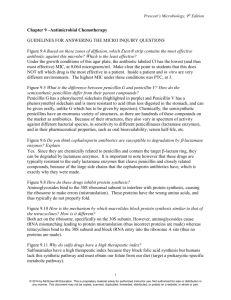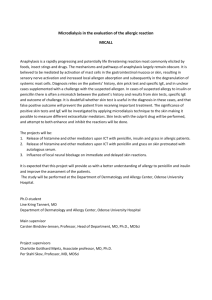הודעה על החמרה ( מידע בטיחות) בעלון לצרכן
advertisement
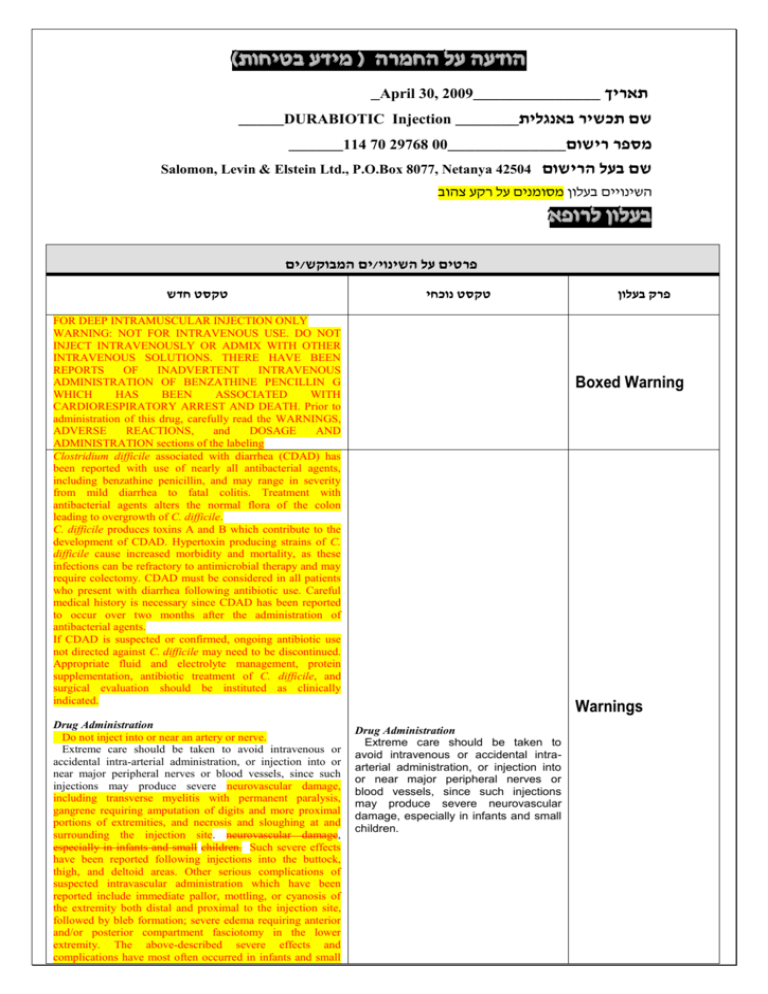
)בטיחות )מידע בטיחות החמרה (( מידע על החמרה הודעה על הודעה _April 30, 2009______________ תאריך _____DURABIOTIC Injection _______שם תכשיר באנגלית ______114 70 29768 00_____________מספר רישום Salomon, Levin & Elstein Ltd., P.O.Box 8077, Netanya 42504 שם בעל הרישום השינויים בעלון מסומנים על רקע צהוב רופא בעלון ללרופא בעלון ים/ים המבוקש/פרטים על השינוי טקסט חדש טקסט נוכחי FOR DEEP INTRAMUSCULAR INJECTION ONLY WARNING: NOT FOR INTRAVENOUS USE. DO NOT INJECT INTRAVENOUSLY OR ADMIX WITH OTHER INTRAVENOUS SOLUTIONS. THERE HAVE BEEN REPORTS OF INADVERTENT INTRAVENOUS ADMINISTRATION OF BENZATHINE PENCILLIN G WHICH HAS BEEN ASSOCIATED WITH CARDIORESPIRATORY ARREST AND DEATH. Prior to administration of this drug, carefully read the WARNINGS, ADVERSE REACTIONS, and DOSAGE AND ADMINISTRATION sections of the labeling Clostridium difficile associated with diarrhea (CDAD) has been reported with use of nearly all antibacterial agents, including benzathine penicillin, and may range in severity from mild diarrhea to fatal colitis. Treatment with antibacterial agents alters the normal flora of the colon leading to overgrowth of C. difficile. C. difficile produces toxins A and B which contribute to the development of CDAD. Hypertoxin producing strains of C. difficile cause increased morbidity and mortality, as these infections can be refractory to antimicrobial therapy and may require colectomy. CDAD must be considered in all patients who present with diarrhea following antibiotic use. Careful medical history is necessary since CDAD has been reported to occur over two months after the administration of antibacterial agents. If CDAD is suspected or confirmed, ongoing antibiotic use not directed against C. difficile may need to be discontinued. Appropriate fluid and electrolyte management, protein supplementation, antibiotic treatment of C. difficile, and surgical evaluation should be instituted as clinically indicated. Drug Administration Do not inject into or near an artery or nerve. Extreme care should be taken to avoid intravenous or accidental intra-arterial administration, or injection into or near major peripheral nerves or blood vessels, since such injections may produce severe neurovascular damage, including transverse myelitis with permanent paralysis, gangrene requiring amputation of digits and more proximal portions of extremities, and necrosis and sloughing at and surrounding the injection site. neurovascular damage, especially in infants and small children. Such severe effects have been reported following injections into the buttock, thigh, and deltoid areas. Other serious complications of suspected intravascular administration which have been reported include immediate pallor, mottling, or cyanosis of the extremity both distal and proximal to the injection site, followed by bleb formation; severe edema requiring anterior and/or posterior compartment fasciotomy in the lower extremity. The above-described severe effects and complications have most often occurred in infants and small פרק בעלון Boxed Warning Warnings Drug Administration Extreme care should be taken to avoid intravenous or accidental intraarterial administration, or injection into or near major peripheral nerves or blood vessels, since such injections may produce severe neurovascular damage, especially in infants and small children. children. Prompt consultation with an appropriate specialist is indicated if any evidence of compromise of the blood supply occurs at, proximal to, or distal to the site of injection. Quadriceps femoris fibrosis and atrophy have been reported following repeated intramuscular injections of penicillin preparations into the anterolateral thigh. Use in Geriatrics Clinical studies did not include sufficient numbers of subjects aged 65 and over to determine whether they respond differently from younger subjects. Other reported clinical experience has not identified differences in responses between the elderly and younger patients. In general, dose selection for an elderly patient should be cautious, usually starting at the low end of the dosing range, reflecting the greater frequency of decreased hepatic, renal, or cardiac function, and of concomitant disease or other drug therapy. This drug is known to be substantially excreted by the kidney, and the risk of toxic reactions to this drug may be greater in patients with impaired renal function. Because elderly patients are more likely to have decreased renal function, care should be taken in dose selection, and it may be useful to monitor renal function. In the treatment of group A -hemolytic streptococcal infections, therapy with this drug should be continued for at least 10 days to help prevent the occurrence of acute rheumatic fever or glomerulonephritis. Following completion of treatment, cultures should be taken to determine whether streptococci have been eradicated. Penicillin should be used with caution in individuals with histories of significant allergies and/or asthma. Care should be taken to avoid intravenous or intra-arterial administration, or injection into or near major peripheral nerves or blood vessels, since such injections may produce neurovascular damage. (See Warnings) The use of antibiotics may result in overgrowth of nonsusceptible organisms. Constant observation of the patient is essential. If new infections due to bacteria or fungi appear during therapy, the drug should be discontinued and appropriate measures taken. Whenever allergic reactions occur, penicillin should be withdrawn unless, in the opinion of the physician, the condition being treated is life-threatening and amenable only to penicillin therapy. When treating gonococcal infections in which primary and secondary syphilis are suspected, proper diagnostic procedures, including dark-ground microscopy, should be carried out before initiating penicillin therapy. Monthly serological tests should be conducted thereafter for at least four months. All cases of penicillin-treated syphilis should undergo clinical and serological examination every 6 months for 2-3 years. In infections suspected to staphylococcal in origin, proper laboratory studies including susceptibility tests, should be performed. As with any potent drug, periodic assessment of renal, hepatic and hematopoietic functions should be made during prolonged therapy. The possibility of superinfection with mycotic or bacterial pathogens should be kept during therapy. If superinfection occurs, appropriate therapy should be instituted. Diarrhea is a common problem caused by antibiotics which usually ends when the antibiotic is discontinued. Sometimes after starting treatment with antibiotics, patients can develop watery and bloody stools (with or without stomach cramps and fever) even as late as two months after having taken the last dose of the antibiotic. If this occurs, patients should contact their physician as soon as possible. In the treatment of group A -hemolytic streptococcal infections, therapy with this drug should be continued for at least 10 days to help prevent the occurrence of acute rheumatic fever or glomerulonephritis. When treating gonococcal infections in which primary and secondary syphilis are suspected, proper diagnostic procedures, including dark-ground microscopy, should be carried out before initiating penicillin therapy. Monthly serological tests should be conducted thereafter for at least four months. All cases of penicillin-treated syphilis should undergo clinical and serological examination every 6 months for 2-3 years. In infections suspected to staphylococcal in origin, proper laboratory studies including susceptibility tests, should be performed. As with any potent drug, periodic assessment of renal, hepatic and hematopoietic functions should be made during prolonged therapy. The possibility of superinfection with mycotic or bacterial pathogens should be kept during therapy. If superinfection occurs, appropriate therapy should be instituted. Precautions Hypersensitivity Anaphylaxis (including shock and death) is the most serious potential adverse reaction to a penicillin drug. It is usually associated with the administration of parenteral rather than oral dosage forms. Serious anaphylactoid reactions require immediate emergency treatment with adrenaline. Oxygen, intravenous steroids and airway management including intubation, should also be administered as indicated (see Warnings). Erythematous maculopapular rashes, urticaria, and occasional cases of exfoliative dermatitis, erythema multiforme and Stevens-Johnson syndrome have been reported. Laryngeal edema and serum sickness-like reactions including chills, fever, edema and arthralgia and prostration have also been reported. Such reactions may be controlled with antihistamines and, if necessary, systemic corticosteroids. Whenever such reactions occur, the drug should be discontinued unless, in the opinion of the physician, the condition being treated is life-threatening and amenable only to penicillin therapy. Gastrointestinal: Pseudomembranous colitis. Onset of pseudomembranous colitis symptoms may occur during or after antibacterial treatment. (See Warnings) Hematological Hematological reactions including hemolytic anemia, thrombocytopenia, thrombocytopenic purpura, eosinophilia, leukopenia and agranulocytosis have been observed. These are believed to be hypersensitivity phenomena and are usually reversible upon discontinuation of therapy. Central Nervous System Rare cases of reversible hyperactivity, agitation, anxiety, insomnia, confusion, behavioral changes, and/or dizziness have been reported. Neuropathy has also been reported. Renal Interstitial nephritis and nephropathy are infrequent and usually associated with high doses of parenteral penicillin. The following adverse events have been temporally associated with parenteral administrations of penicillin G benzathine: Body as a Whole: Hypersensitivity reactions including allergic vasculitis, pruritis, fatigue, asthenia, and pain; aggravation of existing disorder; headache. Cardiovascular: Cardiac arrest; hypotension; tachycardia; palpitations; pulmonary hypertension; pulmonary embolism; vasodilation; vasovagal reaction; cerebrovascular accident; syncope. Gastrointestinal: Nausea, vomiting; blood in stool; intestinal necrosis. Hemic and Lymphatic: Lymphadenopathy. Injection Site: Injection site reactions including pain, inflammation, lump, abscess, necrosis, edema, hemorrhage, cellulitis, hypersensitivity, atrophy, ecchymosis, and skin ulcer. Neurovascular reactions including warmth, vasospasm, pallor, mottling, gangrene, numbness of the extremities, cyanosis of the extremities, and neurovascular damage. Hypersensitivity Anaphylaxis is the most serious potential adverse reaction to a penicillin drug. It is usually associated with the administration of parenteral rather than oral dosage forms. Serious anaphylactoid reactions require immediate emergency treatment with adrenaline. Oxygen, intravenous steroids and airway management including intubation, should also be administered as indicated (see Warnings). Erythematous maculopapular rashes, urticaria, and occasional cases of exfoliative dermatitis, erythema multiforme and Stevens-Johnson syndrome have been reported. Laryngeal edema and serum sickness-like reactions including chills, fever, edema and arthralgia have also been reported. Such reactions may be controlled with antihistamines and, if necessary, systemic corticosteroids. Whenever such reactions occur, the drug should be discontinued unless, in the opinion of the physician, the condition being treated is life-threatening and amenable only to penicillin therapy. Hematological Hematological reactions including hemolytic anemia, thrombocytopenia, thrombocytopenic purpura, eosinophilia, leukopenia and agranulocytosis have been observed. These are believed to be hypersensitivity phenomena and are usually reversible upon discontinuation of therapy. Central Nervous System Rare cases of reversible hyperactivity, agitation, anxiety, insomnia, confusion, behavioral changes, and/or dizziness have been reported Renal Interstitial nephritis and nephropathy are infrequent and usually associated with high doses of parenteral penicillin. Adverse events Metabolic: Elevated BUN, creatinine, and SGOT. Musculoskeletal: Joint disorder, periostitis; exacerbation of arthritis; myoglobinuria; rhabdomyolysis. Nervous System: Nervousness; tremors; dizziness; somnolence; confusion; anxiety; euphoria; transverse myelitis; seizures; coma. A syndrome manifested by a variety of CNS symptoms such as severe agitation with confusion, visual and auditory hallucinations, and a fear of impending death (Hoigne's syndrome), has been reported after administration of penicillin G procaine and, less commonly, after injection of the combination of penicillin G benzathine and penicillin G procaine. Other symptoms associated with this syndrome, such as psychosis, seizures, dizziness, tinnitus, cyanosis, palpitations, tachycardia, and/or abnormal perception in taste, also may occur. Respiratory: Hypoxia; apnea; dyspnea. Skin: Diaphoresis. Special Senses: Blurred vision; blindness. Urogenital: Neurogenic bladder; hematuria; proteinuria; renal failure; impotence; priapism. In streptococcal infections, therapy must be sufficient to eliminate the organism; otherwise, the sequelae of streptococcal disease may occur. Cultures should be taken following completion of treatment to determine whether streptococci have been eradicated. Diagnostic Interference


